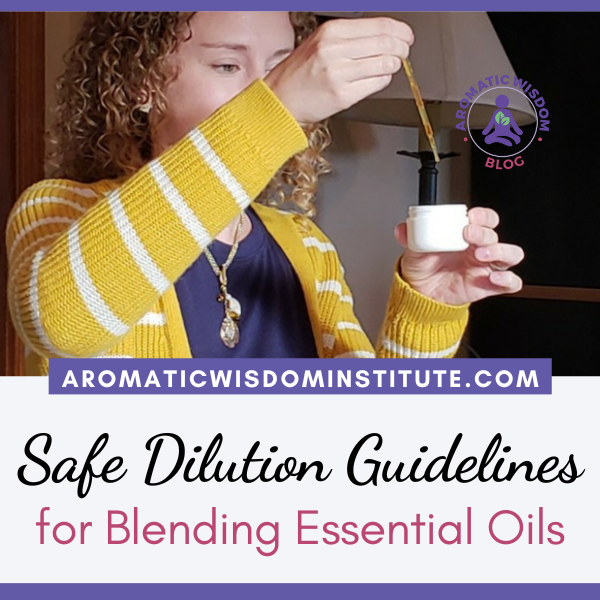Every week on Facebook, Instagram, and Pinterest I get questions about blending:
“Liz, how strong a blend should I make for my husband’s sprained ankle?”
“Liz, I want to use essential oils on my children but don’t know how much is safe.”
“Liz, how many drops of essential oils should I add to cream for my face?”
These are all great questions, and I’m so happy when I get asked! It tells me that people understand the potency of essential oils and that they need to be used with care and respect. There can be uncomfortable, even dangerous, consequences when used incorrectly.
Diluting essential oils is the best practice to follow when applying your oils topically. A few drops really can go a long way when diluted. Using undiluted essential oils is a quick way to get sensitized or irritated skin.
Essential oils are extremely concentrated therefore, understanding dilution is key to safely and effectively using your essential oils.
To dilute essential oils, choose the best carrier oil and dilution that’s appropriate for the issue you are addressing.
Why Dilute Essential Oils?
Here are 4 reasons to dilute essential oils with a carrier oil:
- To reduce the possibility of unpleasant reactions, skin irritation or sensitization
- A more sustainably responsible way to use essential oil
- A more economical way to use essential oils
- To get the added benefit offered by the specific carrier you choose.
Common Carrier Oils for Essential Oils
Fractionated Coconut Oil: This is my personal favorite as both an aromatherapist and massage therapist. It is completely odorless so it doesn’t interfere with the aroma of essential oils and is colorless which is nice when you want to feature the color of something like pink Himalayan salt or blue essential oils. It is very stable with an almost indefinite shelf life.
Jojoba Oil (Wax): Jojoba is actually a liquid plant wax. It’s a favorite among aromatherapists because it is similar to our skin’s natural sebum making it popular in skin care. It has no aroma and a long long shelf life. It’s a popular carrier for skin massage blends and roll-on recipes as well as for making salves and ointments. Being a wax, it will get hard if left in a cold location.
Avocado Oil: This carrier is gorgeous and high in vitamin A and vitamin D. I love it for dry or irritated skin or simply for a heavier carrier in the winter. It is fairly stable and has a shelf life of 1-2 years.
Sweet Almond Oil: A wonderful carrier oil that has emollient, softening and nourishing properties on the skin. Perfect for all ages, including children and babies. Avoid if you have nut allergies.
Rosehip Oil: This is a more costly carrier, but worth every penny. Rosehip oil has properties that are amazing for mature skin and scarring (especially nice with Helichrysum essential oil)
When NOT to Use a Carrier with Essential Oils
- Diffusion: Do not add a carrier oil to your diffusion apparatus as the heavy oil will damage your diffuser.
- Nasal Inhaler: When adding drops of essential oil to the cotton wick that slips inside the inhaler, it is not necessary to use a carrier, though many people do that.
- Aromatically: When you’re simply sniffing from the bottle.
Essential Oil Safe Dilution Guidelines
Here is a general guideline to go by for diluting essential oils. Keep in mind that some essential oils have maximum dermal levels for safe use so that would need to be considered. You can always check the Essential Oil Safety book by Robert Tisserand for the dermal level.
Phototoxic essential oils should be given extra attention with topical application. I have a podcast episode all about using phototoxic essential oils. You can listen here: AWP 036: Phototoxic Essential Oils
There are also some essential oils that should be avoided, regardless of dilution when blending for pregnant or breastfeeding women, children, and people who have special medical conditions and illnesses.
Below I’ve made a simple chart you can print out and keep at your blending table for easy reference. These are the dilutions we use in the classroom at the Aromatic Wisdom Institute. When in doubt, use less!
| Weight of Carrier | 1% dilution | 2% dilution | 3% dilution |
| 1 ounce | 5-6 drops | 10-12 drops | 15-18 drops |
| 2 ounce | 10-12 drops | 20-24 drops | 30-36 drops |
| 4 ounce | 20-24 drops | 40-48 drops | 60-72 drops |
1% DILUTION: — This dilution is used for children under 12, seniors over 65, pregnant women, and people with long-term illnesses or immune systems disorders. A 1% dilution is also a good place to start with individuals who are generally sensitive to fragrances, chemicals or other environmental pollutants.
2% DILUTION — This dilution is used on adults in good health for blends that support skin care, natural perfumes, bath oils, and blends you use every day or long-term.
3% DILUTION — This dilution is used when creating a blend for an acute injury, pain relief, or getting through a cold or flu. Blends made at this dilution are used only for a week or two.
Neat: Using essential oils “neat” (meaning undiluted – essential oil without any carrier) is inadvisable except in very specific situations. There are two reasons for this: 1) you can develop a sensitivity to the oils, and 2) many essential oils are too irritating to use without dilution. Oils can be used neat as follows: In small specific areas, in acute situations (cut or wound, bee sting, bug bite and burn), and for short-term use. These must be the highest quality, non-oxidized oils.
Essential Oil Dilutions
Below you will see the drop count you need for each common-size bottle used with essential oils. It includes 5 mL, 10 mL, and 15 mL bottles. These sizes are usually for roller bottles and smaller single oils or blends with an orifice reducer in the bottle to count out drops. The larger-sized bottles are 1 oz, 2 oz, and 4 oz and are frequently used when creating massage oil blends, beard oil, and body and facial oils.
1/6 oz (5 mL) Carrier Oil |
5 ml = 1 teaspoon
|
1/3 oz (10 mL) of Carrier Oil |
10 ml = 2 teaspoons
|
1/2 oz (15 mL) Carrier Oil |
15 ml = 3 teaspoons or 1 tablespoon
|
1 oz (30 mL) of Carrier Oil |
1 oz = 6 teaspoons or 2 tablespoons
|
2 oz (60 mL) Carrier Oil |
2 oz = 4 tablespoons or 1/4 cup
|
4 oz (120 mL) Carrier Oil |
4 oz = 8 tablespoons or 1/2 cup
|
Don’t worry if your blend doesn’t have the exact number of drops the chart is recommending. That’s why it’s called a “guideline.” It can be a challenge to get a precise measurement because of the varying viscosity of essential oils. Further, not all orifice reducers (the plug inside the essential oil bottle) are the exact same, meaning drops are not uniform.





Very concise chart. I appreciate that. Question: Would there be anytime when you would go above a 3% dilution? Thank you.
Hi Irene,
This a great question and the answer is “yes”! This is when I go above 3%:
For specific injury for muscle, tendon, bone, you can use 3-10% depending on the individual, age, situation and oils being used. 3% dilution is the safest dilution to begin with.
For local issues such as chest congestion you can use 3-10% again, depending on the individual, age, situation and oils being used.
If problem is acute and severe, you can go up to 25% dilution for short-term use, but I rarely find the need to use this much oil. (These problems include severe muscle cramps, intense spasms, significant bruising or pain.)
It really doesn’t take much essential oil to positively affect an area.
Thanks for asking Irene!
Very helpful and easy to understand. Staying in the limits of the chart, makes the use of essential oils safe.
Thanks for this information!
Thanks for stopping by! I agree…being a visual person, I love charts – or anything that I can see at a glance!
I am taking my first aromatherapy class. The table is so helpful. Question I have is if you are making a blend of oils, is there a table that provides each essential oils blending factor? Other than the concept of high, middle and low notes blending (which I have yet to wrap my head around), is there an easier way to blend oils for specific needs, i.e., muscle aches blend?
My question is whether or not you know the blending factor for the full list of oils used in aromatherapy and if it is not available through this website, do you know where that information can be located. Most websites that provide essential oils do not list the blending factor for each, though it may include whether it is a high or a low. It is almost impossible to find a blending factor chart, and most that are offered online are dilution ratios, not blending factors.
Hi Jennifer, I’d love to be able to help. Can you clarify what you mean by “blending factors”? I have always considered dilution ratios the primary considering for creating a formula because it is a safety issue. With “blending factors” is something else taken into consideration?
Does it make a difference if you’re blending in a solid form (like shea, etc)?
Also, does this apply to all oils (some are more dense than others). Is there a rule of thumb for the amount of oil to use for top, middle & high notes?
Thank you!
Thank you so much, this is such a super handy chart, especially for a beginner!
Hi,
Can you tell me what a blending sheet is please as I have to complete one for my aromatherapy course.
Kind Regards
Maggie
Hi Maggie, A blending sheet is simply a paper where you write down the recipe for your blend with oils, number of drops, dilution ratio and anything else you want to record about the blend. We use one in my classroom, but I’m sure the teacher of your aromatherapy course has one. If you’d like, I have a great journal on Amazon that I created specifically for people like you 🙂 It is called My Books of Blends” You can find it on Amazon Here: MY BOOK OF BLENDS.
I love your book Liz. It’s has become my own little book of treasured blends. It’s wonderful to have a place to record all of my “concoctions” and make notes on them.
Awwwww that’s warms my heart Hope! Thank you for sharing 🙂
Just learning all this fun educational issues. See if I understand this correctly. If I have a recipe that has 3 essential oils and it says 10 drops each that would be 2 oz carrier 3% dilution What is the dilution for roller bottle then. I think I made mine to strong. It was 4 EO – 20 drops of each. Then filed with coconut oil
Was for my 3 year shingle pain. It works great. Not got but it relieves the pain if use in morning and night… After 3 years I can sleep on my right side now with no pain.. Do you think I can use this strength long term… Thank you for you time.
This is an absolutely helpful website. The information is stated so clearly.
thank!